What Were The Dominant Animals Of The Mesozoic Era
Mesozoic Era Animals
Examples of Mesozoic Era animals include dinosaurs, pterosaurs, ammonites, sharks, plesiosaurs, ichthyosaurs, mosasaurs, pseudosuchians, insects, and early mammals. Although dinosaurs were the dominant state animals of the Mesozoic Era, many other important animal groups evolved and thrived during this time.
On this folio is a listing of Mesozoic Era animals with pictures, facts, and links to further information…
Introduction
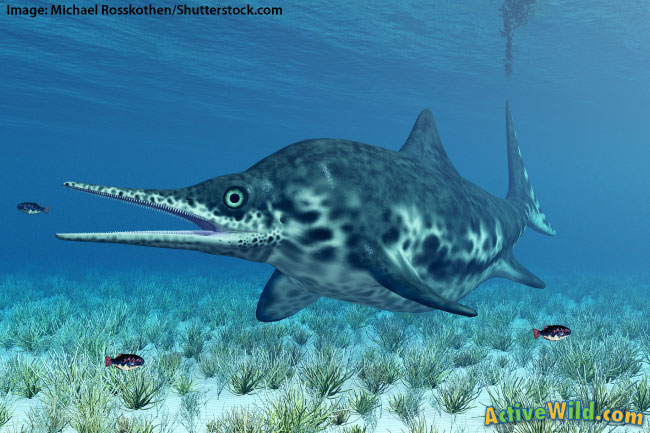
The Mesozoic Era began 251.902 mya (1000000 years ago) and lasted for 185.9 1000000 years. For much of this fourth dimension, reptiles were the dominant vertebrate animals, non just on land (in the class of dinosaurs), but too in the air (in the form of pterosaurs) and in the sea (in the form of plesiosaurs, ichthyosaurs and mosasaurs).
The Mesozoic Era has been termed the "Age of Reptiles" due to the dominance of this grouping of animals.
The Mesozoic Era ended 66 mya (million years ago) with a mass extinction effect idea to have been caused by a meteor strike.
Below is a list of animals from the Mesozoic Era. The list includes only Mesozoic Era animals that are not dinosaurs; then if you want to discover the dinosaurs of the Mesozoic Era, bank check out these pages instead:
- Triassic Dinosaurs with Pictures and Facts
- Jurassic Dinosaurs List with Pictures and Facts
- Cretaceous Dinosaurs List with Pictures and Facts
Page Index
The Mesozoic Era is divided into three periods: Triassic, Jurassic and Cretaceous. You tin can use the index below to meet Mesozoic animals from each of these periods, or scroll down to see all of the animals.
- Mesozoic Animals From The Triassic Flow
- Mesozoic Animals From The Jurassic Period
- Mesozoic Animals From The Cretaceous Period
Mesozoic Era Animals List
Mesozoic Animals From The Triassic Menses
Ceratites
- Type of animal: Cephalopod, Ammonite
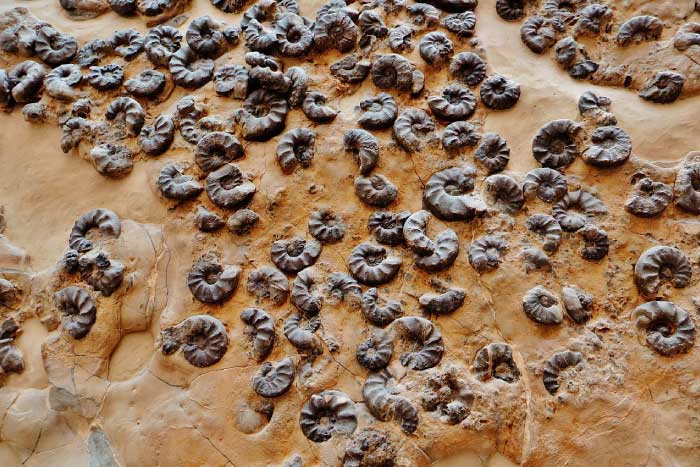
Ceratites was a genus of ammonite that lived in the early and centre Triassic Menstruum. It belonged to a larger group of ammonites, the order Ceratitida. Well-nigh Triassic ammonites belonged to this grouping.
Ammonites became extinct at the end of the Mesozoic Era.
- You lot tin can find out more about ammonites on this page: Ammonite Facts
Effigia
- Type of animal: Pseudosuchian archosaur

Effigia was a 10 ft. / iii grand long, fast-moving, bipedal reptile. Despite closely resembling dinosaurs of family Ornithomimidae, it was a pseudosuchian.
Pseudosuchians were a group of reptiles that competed with early on dinosaurs in the Triassic Flow. They include the ancestors of today'southward crocodiles.
Effigia lacked teeth, and instead broke its food apart with a beak. It is believed to take been an omnivore, feeding on vegetation and pocket-size animals.
This Mesozoic animal was discovered in the Ghost Ranch Quarry, a fossil hotspot located in New Mexico, USA.
Eudimorphodon
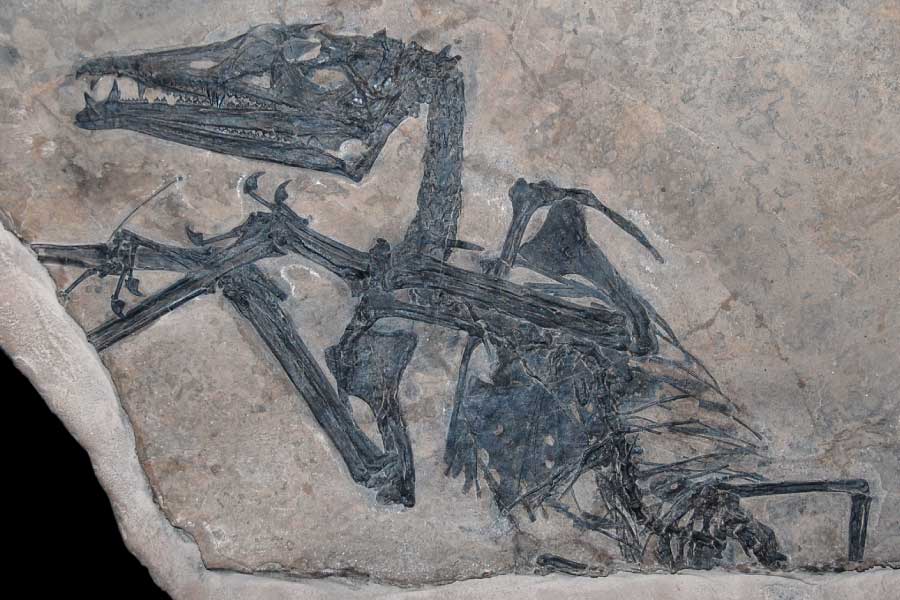
- Type of brute: Pterosaur
Eudimorphodon is 1 of the earliest-known pterosaurs. This flying reptile of the Belatedly Triassic Catamenia was outset discovered in what is at present Italian republic.
This Triassic pterosaur had a wingspan of iii.iii ft / one meter and was equipped with claws for climbing on cliffs.
Fossilized fish scales have been constitute with Eudimorphodon fossils, suggesting that the pterosaur was a fish-eater.
- You tin can find out more about pterosaurs on this page: Pterosaur Facts
Hybodus
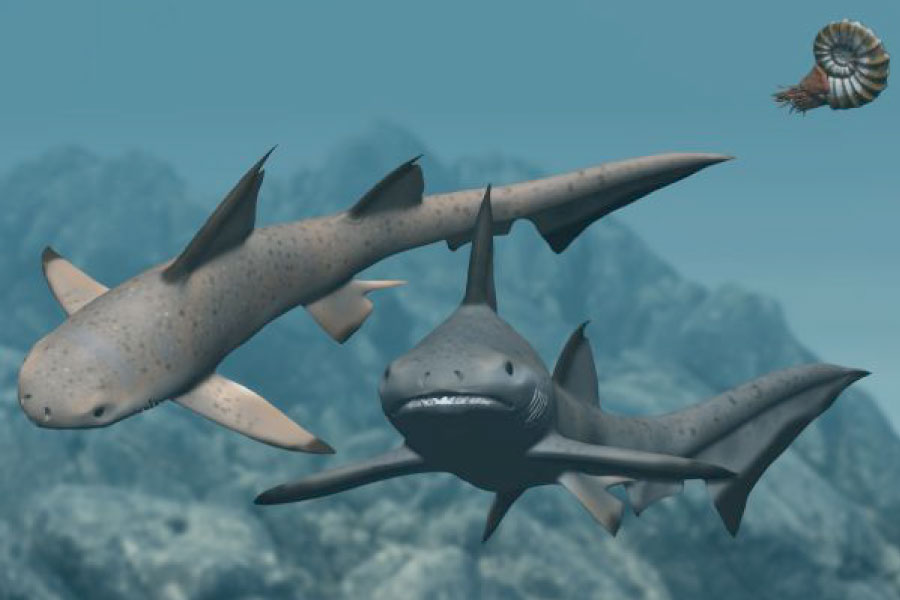
- Type of brute: Fish, Shark
Hybodus was a half dozen.5 ft / 2 m long shark that first appeared in the Permian Period and became extinct in the Late Cretaceous Period.
Like mod sharks, Hybodus replaced its teeth continuously throughout its lifetime. Information technology had two dorsal fins, each of which was supported past a spine, which may accept provided protection from other marine predators of the Mesozoic Era.
Lystrosaurus
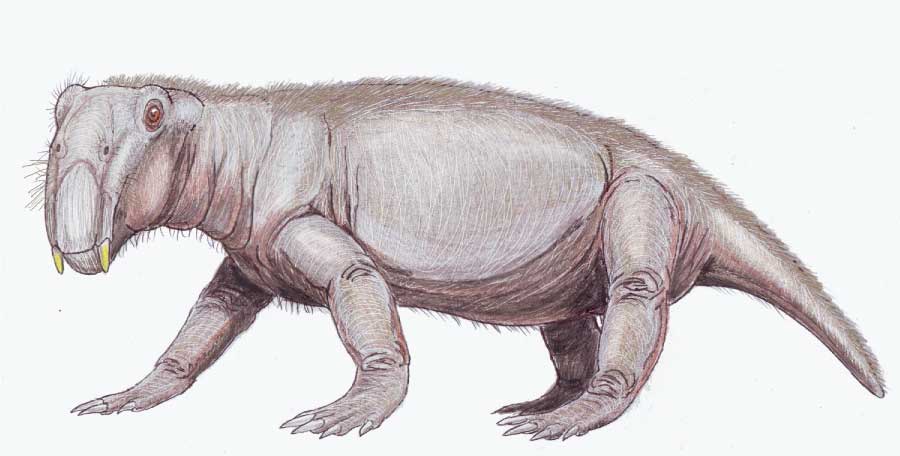
- Type of creature: Dicynodont
Lystrosaurus, a pig-like plant eater, was ane of the few animals to survive the Permian-Triassic Extinction Issue that occurred immediately earlier the Mesozoic Era. It was the most common land vertebrate of the Early Triassic.
The powerful forelimbs of Lystrosaurus propose it may have been a burrower. Information technology had two tusks, and, like all dicynodonts, a hard beak for eating tough vegetation.
Mixosaurus

- Blazon of animal: Ichthyosaur
Mixosaurus was a member of a group of marine reptiles known as ichthyosaurs. Ichthyosaurs are descended from terrestrial (state) reptiles that gradually evolved to alive in the bounding main.
Early ichthyosaurs had long, eel-shaped bodies, whereas later species were more fish-similar in advent.
Mixosaurus is seen every bit a transitional animal between the earlier and later ichthyosaurs – its name means "mixed lizard".
Nothosaurus
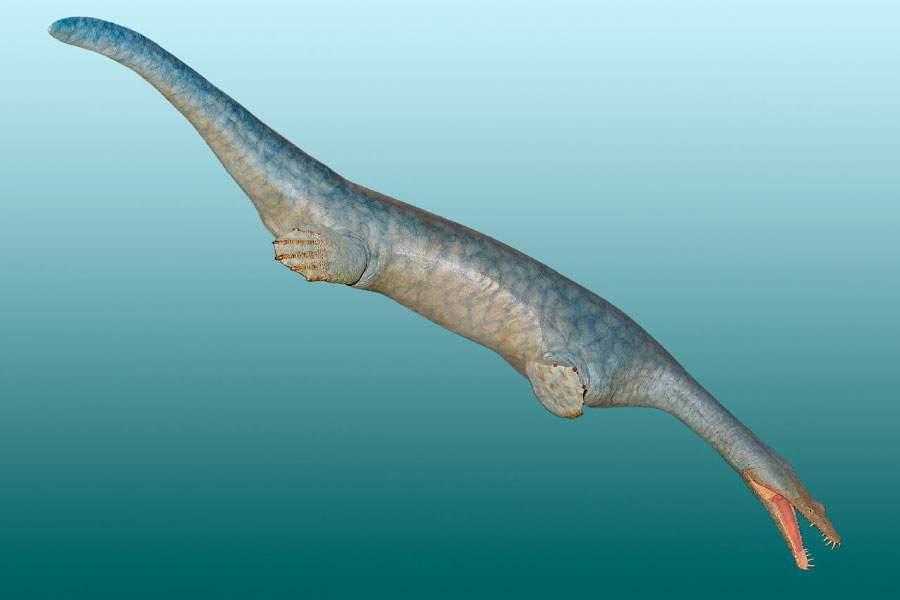
- Blazon of animal: Nothosaur
Nothosaurus was a semi-aquatic marine reptile whose lifestyle is thought to resemble that of modern-solar day seals. With webbed feet and long tail, Information technology was a capable swimmer, all the same was able to haul itself out of the h2o to rest.
Postosuchus

- Type of fauna: Pseudosuchian archosaur
Postosuchus was a fearsome Mesozoic predator that lived in North America in the Late Triassic Period. Information technology belonged to the family Rauisuchidae.
An apex predator, Postosuchus grew up to xv ft / 4.v k in length and preyed on smaller reptiles, including dinosaurs.
Thrinaxodon
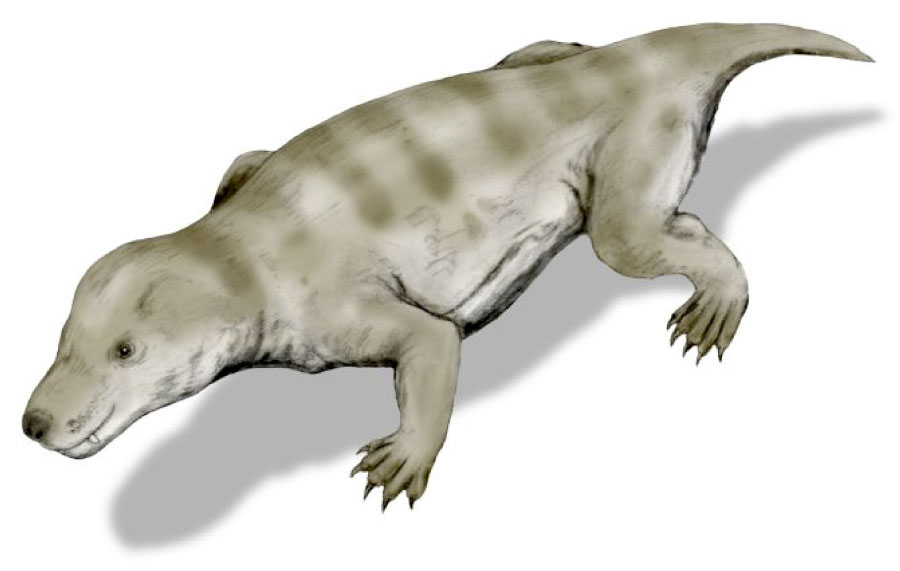
- Type of animate being: Cynodont
Cynodonts were a group of animals that appeared in the Late Permian. Although early cynodonts resembled reptiles, the grouping includes the ancestors of all mammals.
Thrinaxodon was a cynodont that lived in the Early Triassic. It was the size of a cat and mayhap had pilus. Its posture was less sprawling, and more than mammal-like, than that of its ancestors. Information technology was likely an agile predator.
Triadobatrachus
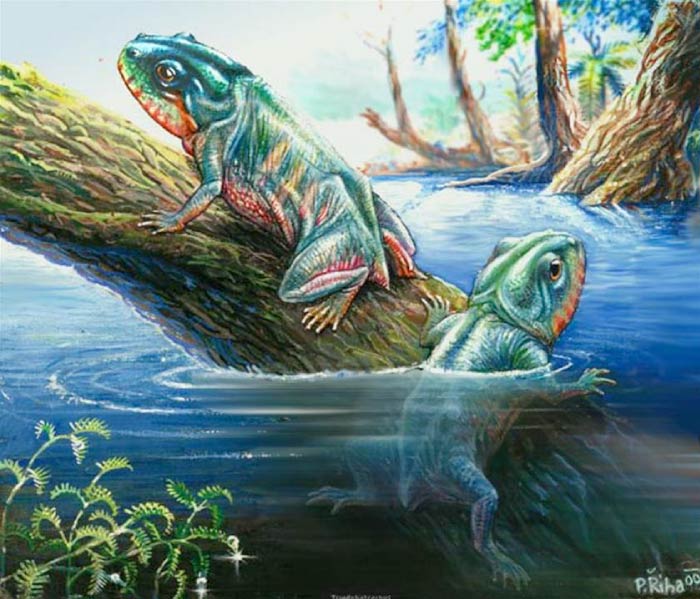
- Type of animal: Amphibian
Triadobatrachus was an amphibian that live in the Early Triassic Period. Information technology was a frog-like animal thought to be a transitional fossil betwixt the first frogs and earlier amphibians.
Mesozoic Animals From The Jurassic Period
Dactylioceras
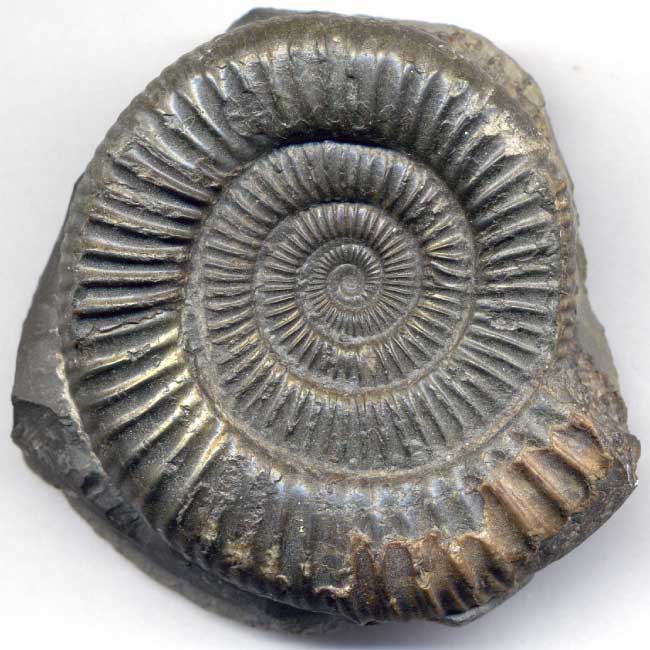
- Blazon of animal: Cephalopod, Ammonite
Dactylioceras is a genus of small ammonite with a heavily ribbed shell. It was abundant in Europe, and can be used to date other fossils from the Early Jurassic Period.
- You can find out more about ammonites on this page: Ammonite Facts
Eocarcinus
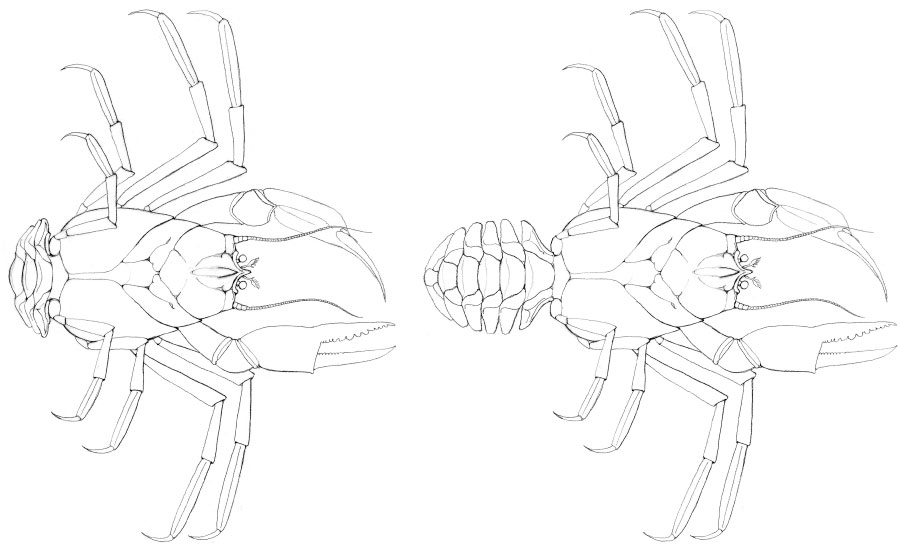
- Type of animal: Crustacean, crab
Eocarcinus is a decapod crustacean from the Early Jurassic. It is either one of the very commencement crabs, or a shut relation of early on crab-like crustaceans. (Decapoda is a group of crustaceans that includes animals such equally crabs, lobsters and prawns.)
- You tin find out more nearly crustaceans on this folio: Crustaceans: The Ultimate Guide
Fruitafossor
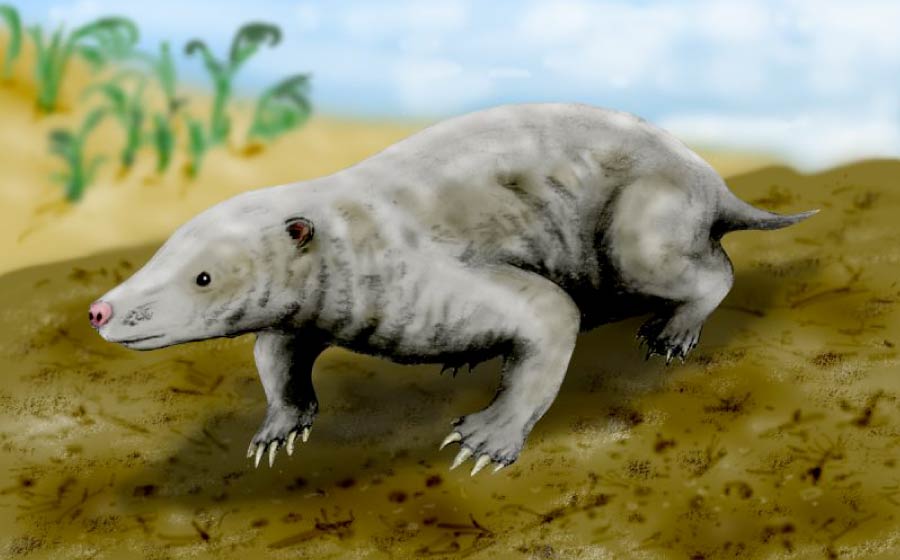
- Type of animate being: Mammal
Fruitafossor was a mammal from the Tardily Jurassic. Information technology had strong forelimbs – a probable accommodation for earthworks. Its teeth are similar to those of mod-day insect-eating animals such as armadillos and aardvarks. Fruitafossor probably ate termites and other insects, digging in the ground to attain its prey.
Ichthyosaurus
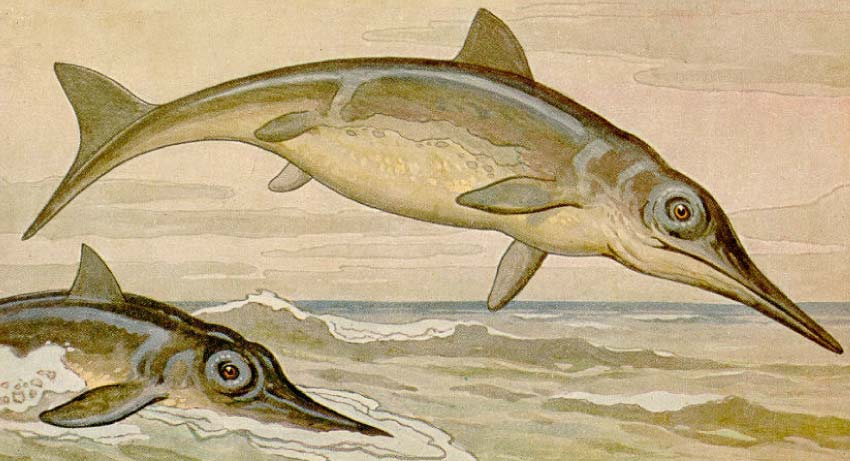
- Type of fauna: Ichthyosaur
Ichthyosaurus was an aquatic reptile that lived in the Tardily Triassic Catamenia. It was half-dozen to 11 ft. (ii to 3.3 chiliad) in length, and bore a striking resemblance to today'south dolphins. This is an example of convergent evolution – the process past which two unrelated species evolve similar characteristics.
Kayentachelys
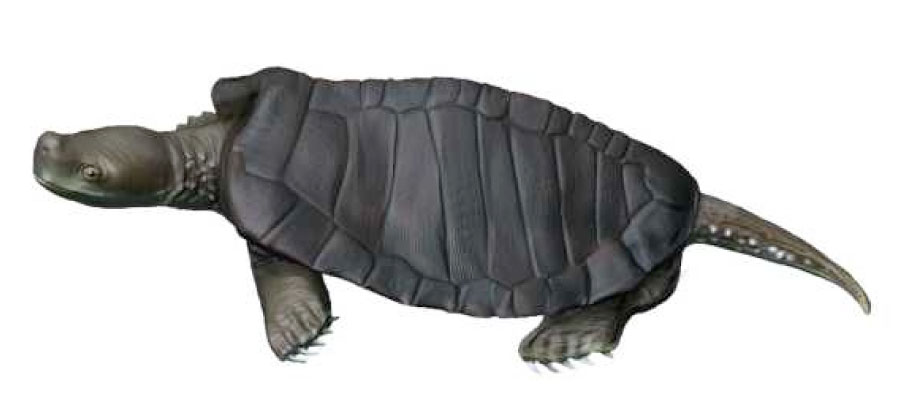
- Blazon of animate being: Turtle
Although not the primeval turtle (turtles are idea to have appeared in the Triassic Period with animals such every bit Odontochelys), Kayentachelys is the first to be found in large numbers.
This small-scale turtle lived in the Early Jurassic, and was discovered in (and named after) the Kayenta Formation in Arizona, USA.
Leedsichthys
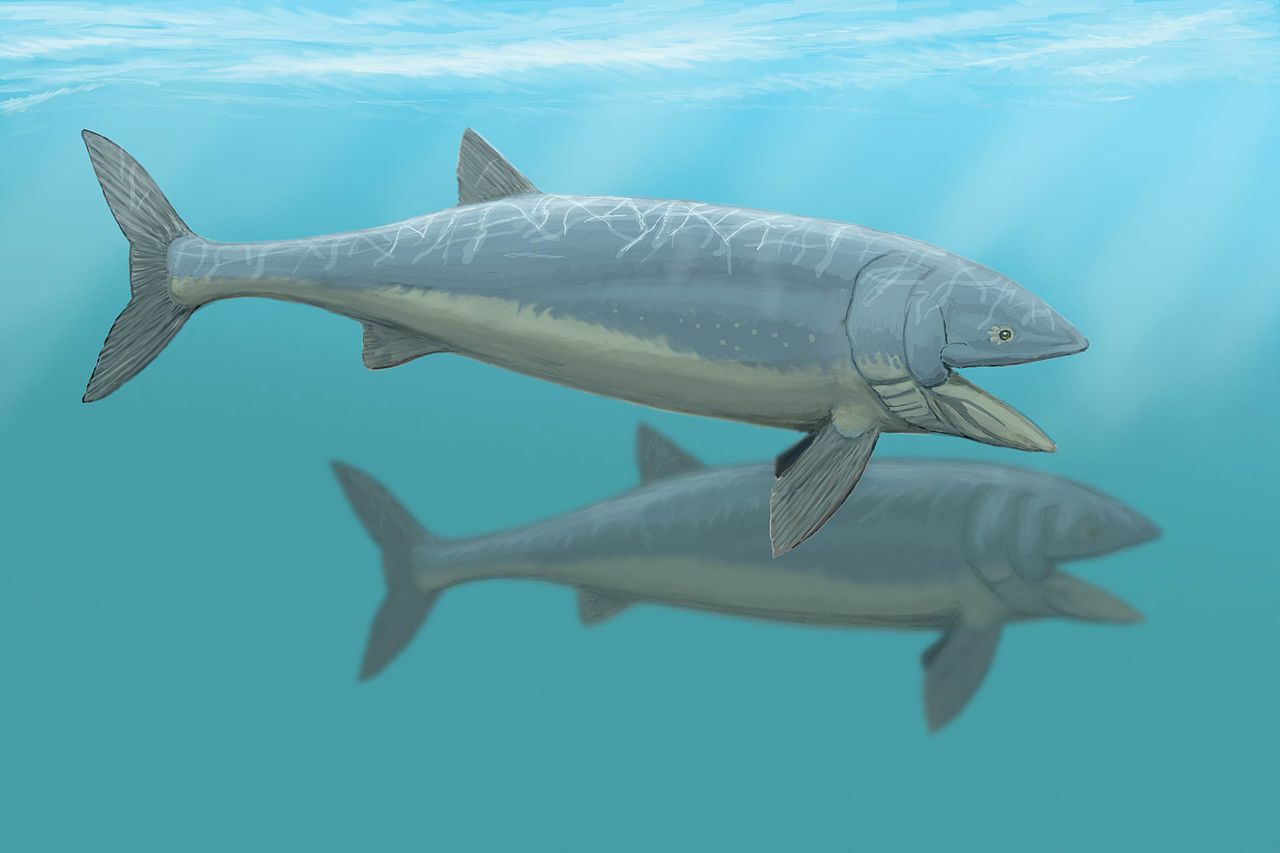
- Blazon of animal: Ray-Finned Fish
Leedsichthys is thought to exist the largest bony fish that ever lived, with an estimated maximum length of 72 ft. / 22m. Fifty-fifty today's whale shark, which is a shark, not a bony fish, rarely, if e'er, attains such a length.
(The bony fish are i of 2 major groups of living fish, the other being the sharks and rays, which have cartilaginous skeletons.)
Like today's baleen whales, Leedsichthys fed by filtering plankton from huge mouthfuls of seawater.
Leedsichthys lived in the Middle and Late Jurassic period, and has been establish in what is now Northern Europe and Chile.
Liopleurodon
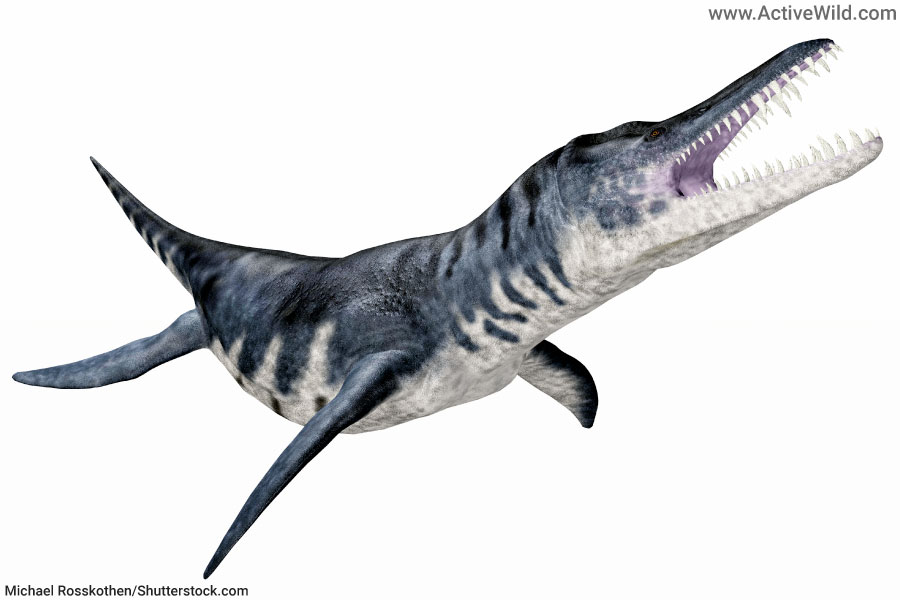
- Type of beast: Pliosaur
Liopleurodon was an noon predator that swam in the oceans of the Centre and Late Jurassic Menstruation.
The maximum length of Liopleurodon was one time thought to be in the region of 80 ft. / 25 g. Today, liopleurodon's maximum size is believed to exist somewhat shorter, at betwixt xx and 23 ft / 6 and vii m – around the size of a modern killer whale.
Pliosaurs were plesiosaurs with short necks and powerful, tooth-filled jaws.
Plesiosaurus
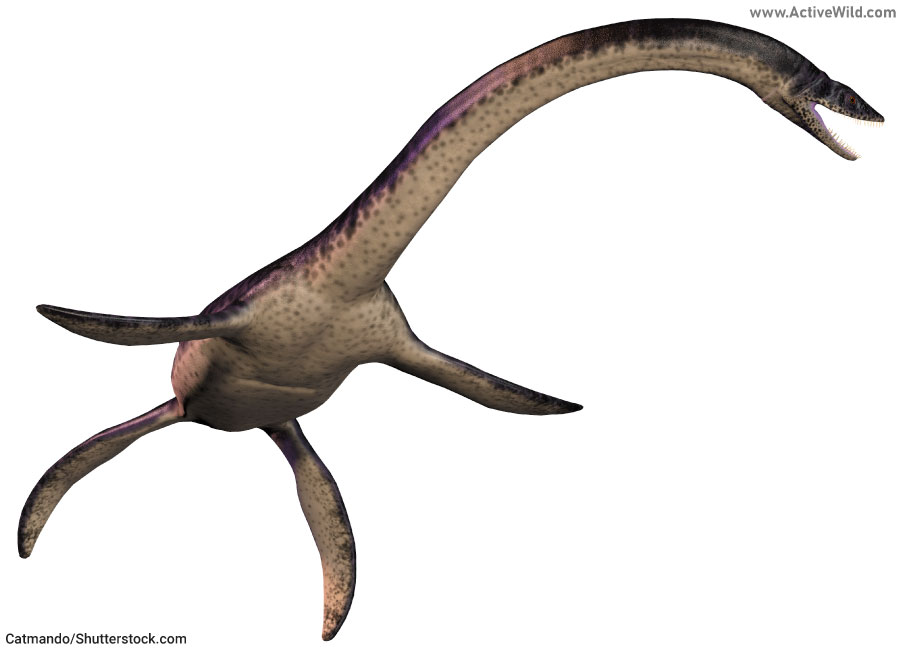
- Type of animal: Plesiosaur
Plesiosaurus was the outset plesiosaur to exist named (by paleontologists Henry De la Beche and William Conybeare in 1821). It gives its proper noun to the entire lodge, Plesiosauria. Today, over 100 species of plesiosaurs take been discovered.
Plesiosaurus was 10 to 16.four ft. / iii to 5 meters in length and had a long neck and a pocket-size caput. Similar other plesiosaurs, it propelled itself through the h2o with 2 pairs of flippers.
All plesiosaurs are believed to have given birth to alive young (rather than laying eggs) and may have been warm-blooded.
Protosuchus
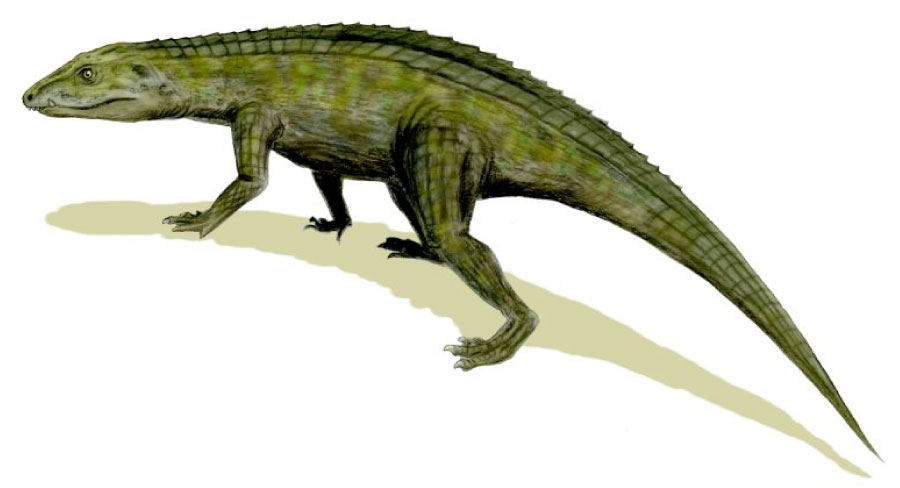
- Blazon of animal: Protosuchid
Between the Triassic and Jurassic Periods Earth underwent a mass extinction in which most of the dinosaurs' main reptilian competitors – the pseudosuchians – became extinct.
The just group of pseudosuchians to survive were the crocodylomorphs – a grouping that contained the ancestors of today's crocodiles, alligators and caimans.
I such beast was Protosuchus – a 3.3 ft. / 1 m long predator that resembled a mod crocodile just with longer legs. With an upright stance, Protosuchus would have been a fast runner that probable hunted on country rather than in the h2o.
Pterodactylus
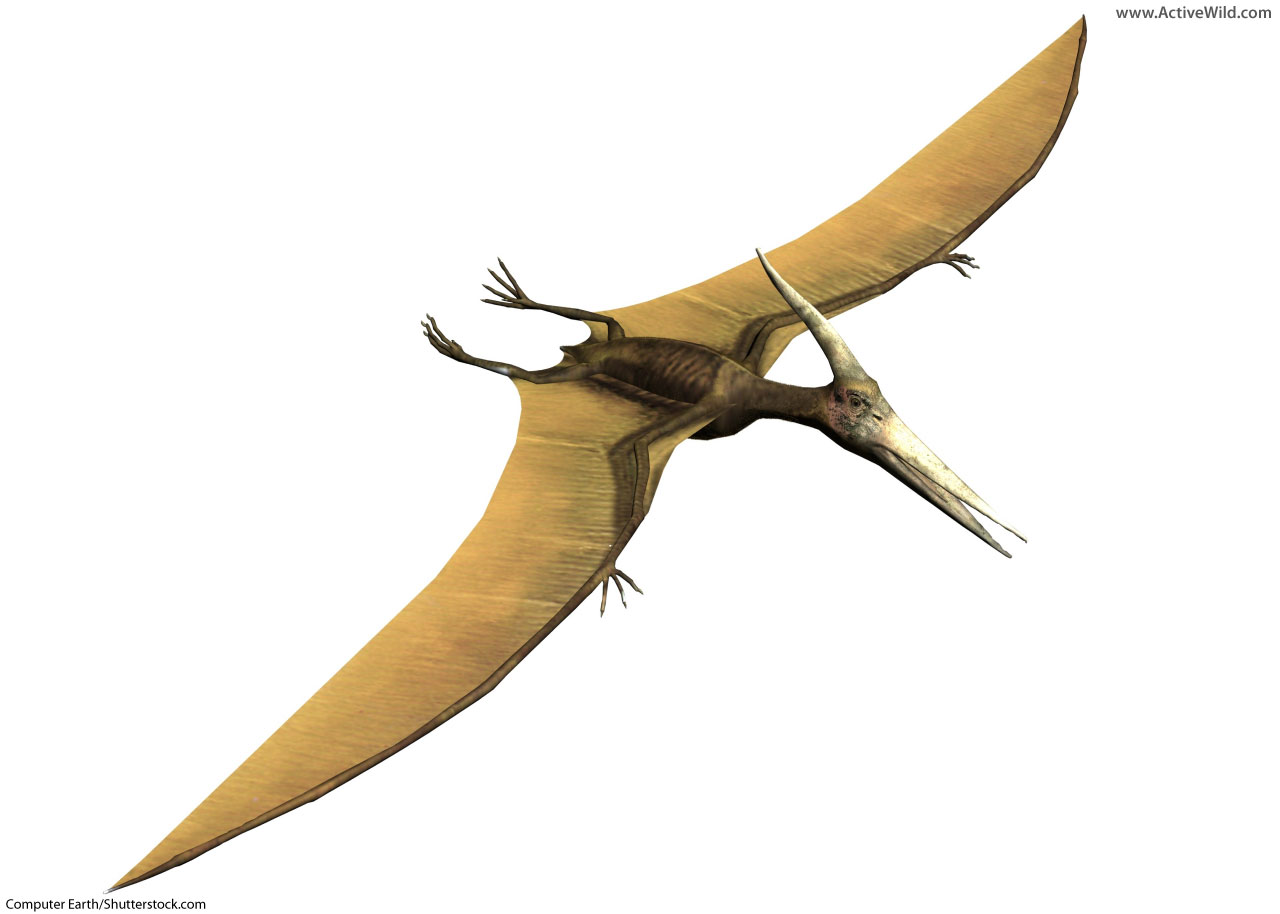
- Type of animal: Pterosaur
Pterodactylus was a pterosaur with a wingspan of effectually 3.iv ft / 1.04 meters. Pterodactylus was the first pterosaur to be discovered and identified as a flying reptile.
Because Pterodactylus is and then well-known, the name "Pterodactyl" is frequently used (incorrectly) to refer to any Pterosaur.
A recent assay of Pterodactylus' teeth suggest that this Mesozoic Era animal mainly preyed on invertebrates.
- You can find out more about pterosaurs on this page: Pterosaur Facts
Mesozoic Animals From The Cretaceous Period
Deinosuchus
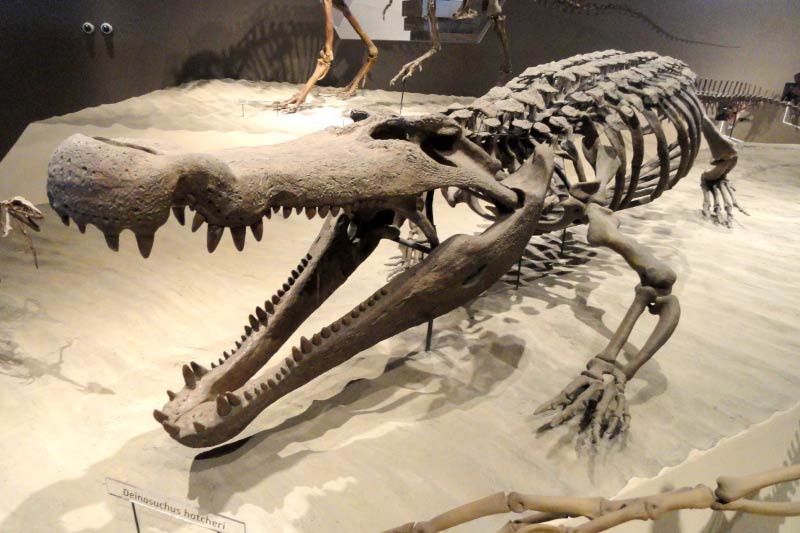
- Type of animal: Crocodilian
They may have ruled most of the land, but the dinosaurs of the Cretaceous Period didn't have it all their own mode: the top predator in some Northward American aquatic habitats was the mighty Deinosuchus – one of the largest crocodilians ever to have lived.
Looking much similar a modern crocodilian, and having a similar lifestyle, Deinosuchus reached lengths of 39 ft. / 12 meters – twice the size of today's largest crocodile, the saltwater crocodile.
Deinosuchus is one of the earliest members of the superfamily Alligatoroidea, which contains animals more closely related to today's alligators than to other crocodilians.
Elasmosaurus
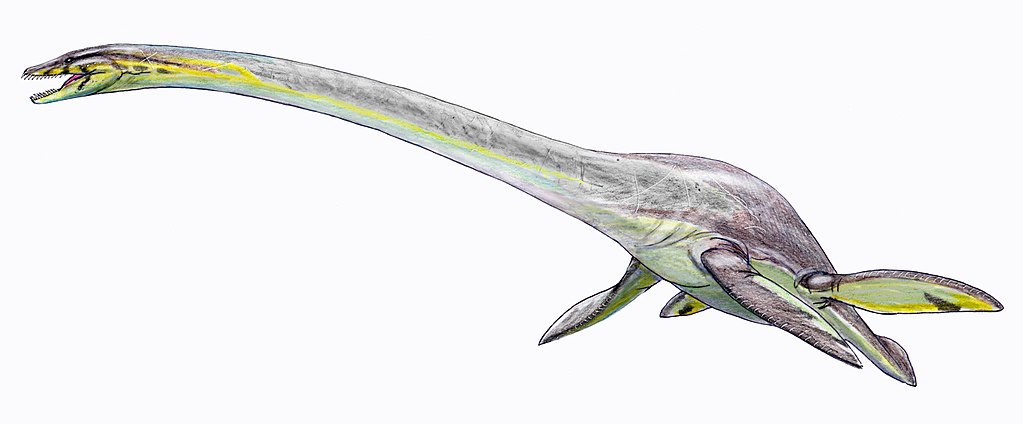
- Blazon of creature: Plesiosaur
Even practiced paleontologists like Edward Drinker Cope make mistakes: when he commencement identified the fossilized remains of Elasmosaurus, Cope idea that the animal's ridiculously long cervix was its tail.
It was an easy mistake to make: Elasmosaurus has 72 neck vertebrae; simply i other animal (Albertonectes, some other plesiosaur) has more.
Elasmosaurus swam in the shallow waters of the Western Interior Seaway, an inland sea that split North America into 2 dissever landmasses during the Late Cretaceous.
Kronosaurus
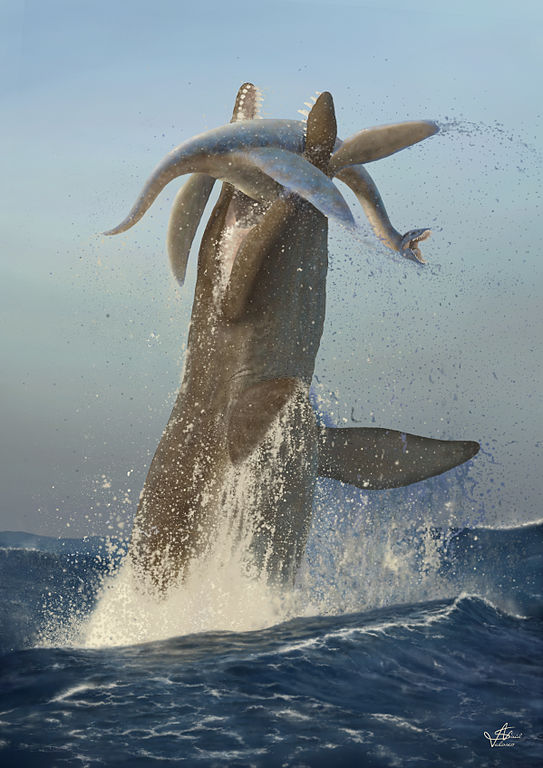
- Type of animal: Pliosaur
Kronosaurus was one of the largest pliosaurs, with a maximum estimated length of around 36 ft. / 10.nine chiliad.
Like all pliosaurs, Kronosaurus was a plesiosaur with a short neck. Information technology swam with is 4 large flippers, and is thought to have fed mainly on big fish.
Mosasaurus
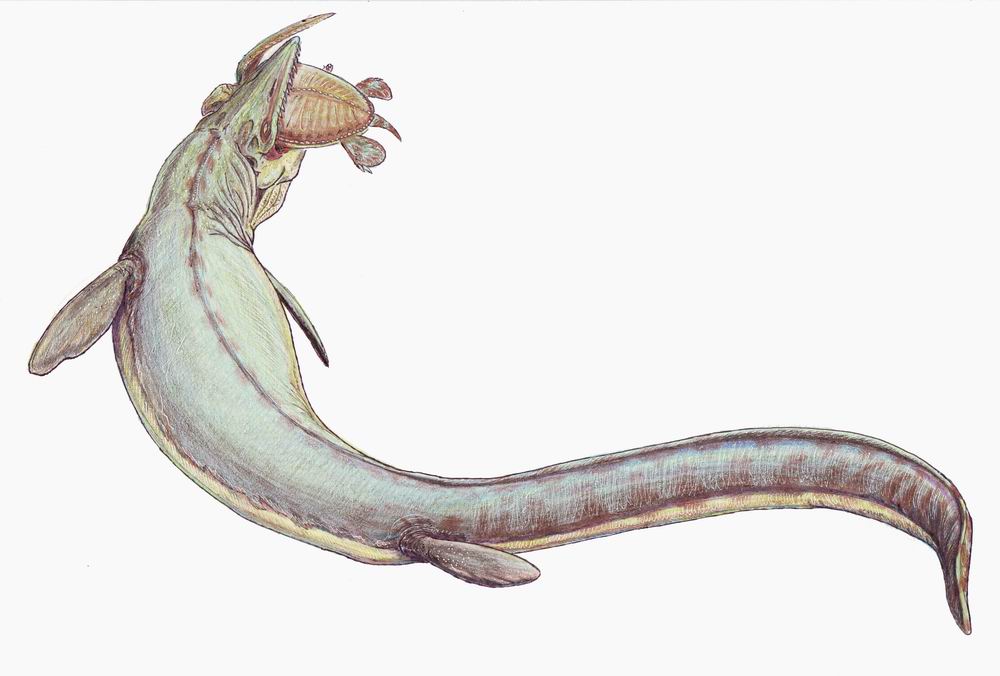
- Blazon of animal: Mosasaur
Mosasaurus was a huge swimming lizard that appeared in the Late Cretaceous menses. This 56 ft. / 17.1 k long aquatic reptile was an apex predator that used bursts of high speed to catch large casualty animals such as turtles, sharks and even other mosasaurs.
Mosasaurs belong to the order Squamata – the order to which today's lizards and snakes belong. Mosasaurs evolved from aquatic lizards and became the dominant marine predators at the very finish of the Mesozoic Era.
Pteranodon
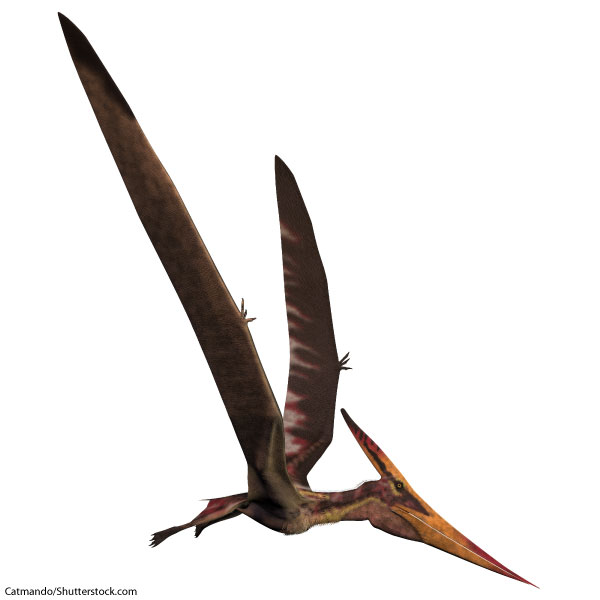
- Type of animal: Pterosaur
With a wingspan of around 23 ft./ 7 thou, Pteranodon was one of the largest-known Pterosaurs.
Like all of the after pterosaurs, Pteranodon lacked both teeth and a tail. Its head was adorned with a large crest. It soared in the Late Cretaceous skies of North America and fed on fish.
- You can find out more than virtually pterosaurs on this folio: Pterosaur Facts
Quetzalcoatlus
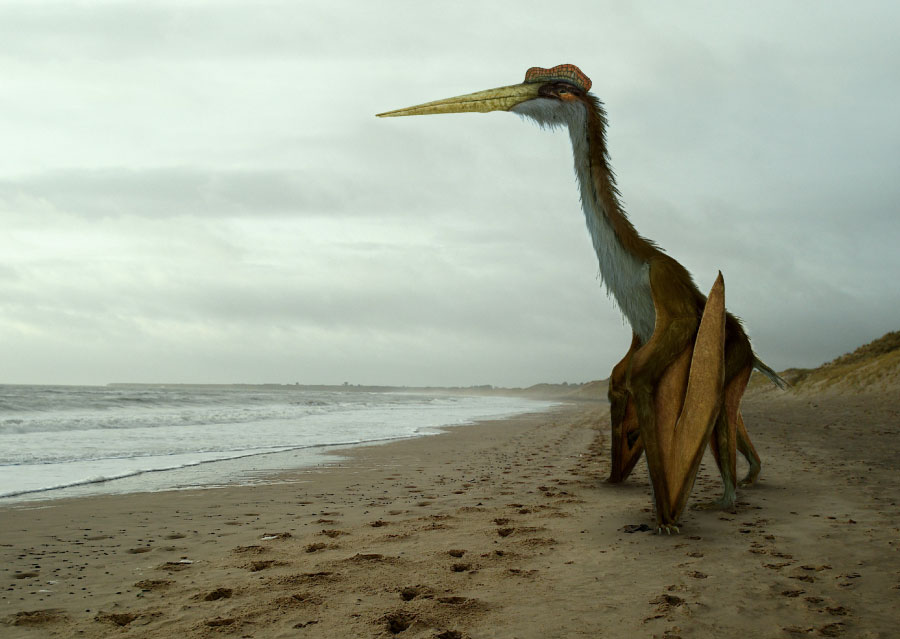
- Blazon of animal: Pterosaur
Pteranodon may have been big, but it was dwarfed past Quetzalcoatlus. With a wingspan of around 36 ft. / 11 m, this huge reptile is among the largest flying animals ever to have lived.
Quetzalcoatlus was discovered in Texas, USA. It is thought to have hunted on land by stalking small vertebrate casualty.
- You lot tin find out more about pterosaurs on this folio: Pterosaur Facts
Scaphites
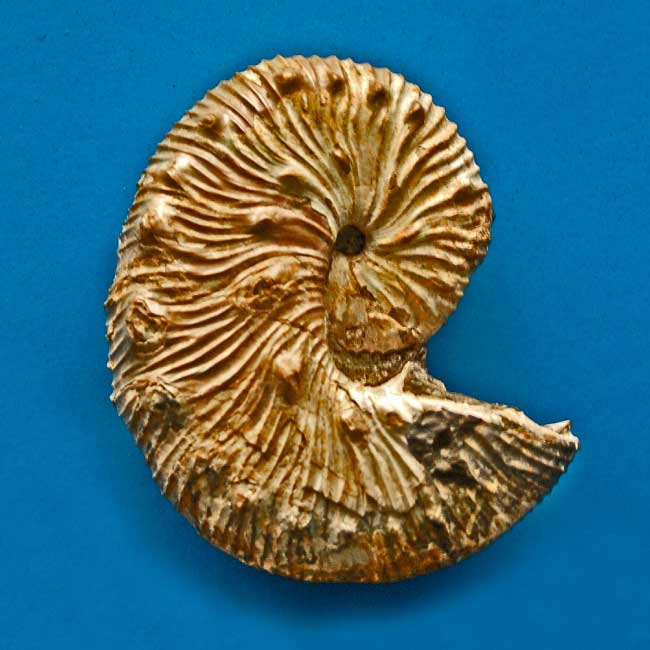
- Type of animal: Cephalopod, Ammonite
Scaphites was a mutual ammonite of the Tardily Cretaceous Period. Information technology has a distinctive "hooked" shape, and was effectually eight" / 20 cm in width.
There is some evidence that some Scaphites survived the Cretaceous-Paleogene Extinction Event at the end of the Mesozoic Era and lived for some time into the Paleocene.
- Yous tin detect out more virtually ammonites on this page: Ammonite Facts
Simosuchus
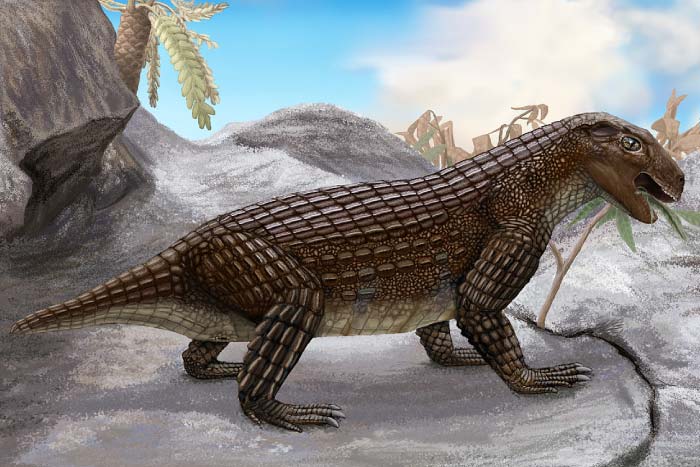
- Type of animal: Crocodylomorph
Simosuchus was a 3.three ft. / one grand long Crocodylomorph that lived in what is now Madagascar in the Tardily Cretaceous.
The trunk of this Mesozoic reptile resembled that of a modern crocodile, but, unlike other crocodiles, its snout was brusk and wide. This, and its leaf-shaped teeth, suggest that Simosuchus may have been a plant eater.
Squalicorax
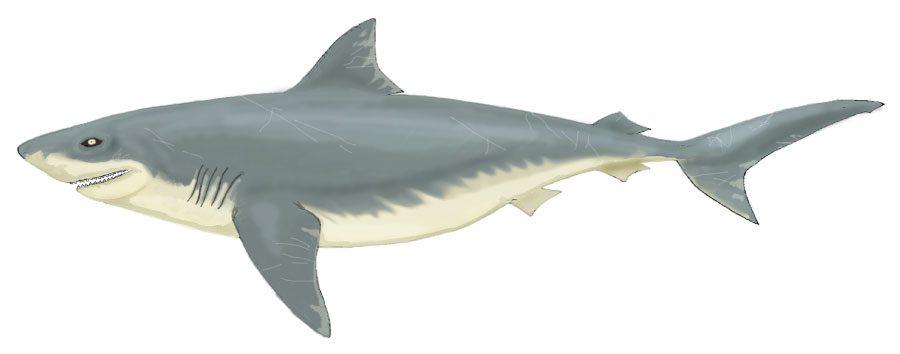
- Blazon of animal: Fish, Shark
Pond in the oceans throughout the Cretaceous Menstruum was Squalicorax, otherwise known as the crow shark. Growing upwards to 16.four ft. / 5m in length, the crow shark likely predated other fish, as well as reptiles such every bit mosasaurs.
A Squalicorax tooth was found embedded in the foot of a hadrosaurid dinosaur. This suggests that Squalicorax was to some extent a scavenger, as hadrosaurids lived on land. The shark would take been feeding on the body of a hadrosaurid that had ended up in the ocean.
Xiphactinus
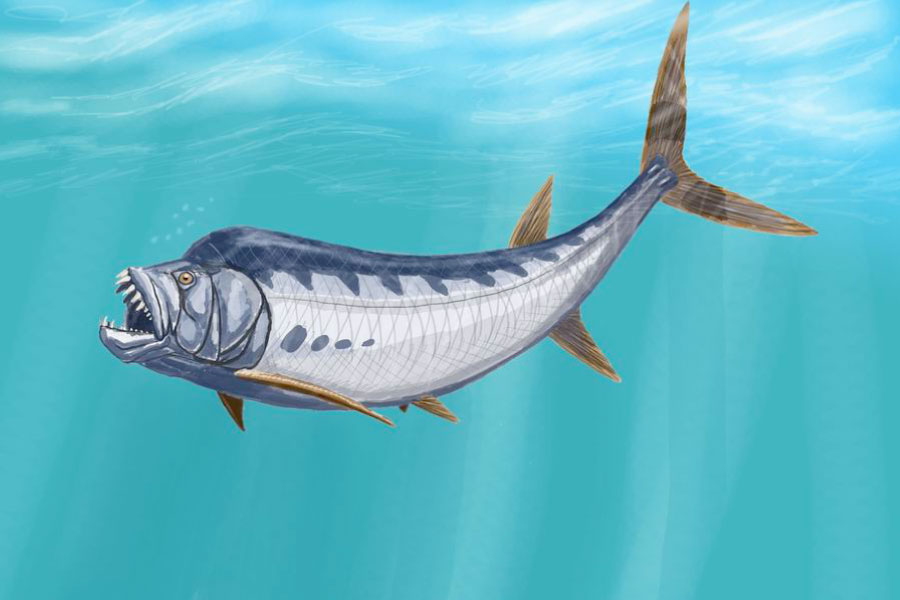
- Blazon of animal: Fish
Growing to around twenty ft. / half-dozen m in length, Xiphactinus was a fearsome Mesozoic fish whose fossilized remains have been found in North and Southward America, Europe and Australia.
Xiphactinus had a forked tail and was built for speed. With a mouthful of sharp teeth, it would take been a formidable predator. Several Xiphactinus fossils have been found with the remains of other fish in their stomachs.
Further Reading: Discover More With Active Wild
You can meet more than Mesazoic Era animals on the following pages:
- Triassic Animals – Find The Animals That Lived With The Dinosaurs In The Triassic Period
- Jurassic Animals – A List Of Animals That Lived In The Jurassic Period (That Weren't Dinosaurs!)
- Cretaceous Menses Animals That Weren't Dinosaurs
What is an Era? What does "Cretaceous Menstruum" mean? Find out here: Geologic Timescale Facts
Discover astonishing dinosaurs on this page: Dinosaur List with Pictures & Facts
Find out more about dinosaurs and prehistoric life:
- Dinosaur Books
- Dinosaur DVDs
- Prehistoric Animal Books
Source: https://www.activewild.com/mesozoic-era-animals/
Posted by: hagemanhimpre.blogspot.com

0 Response to "What Were The Dominant Animals Of The Mesozoic Era"
Post a Comment